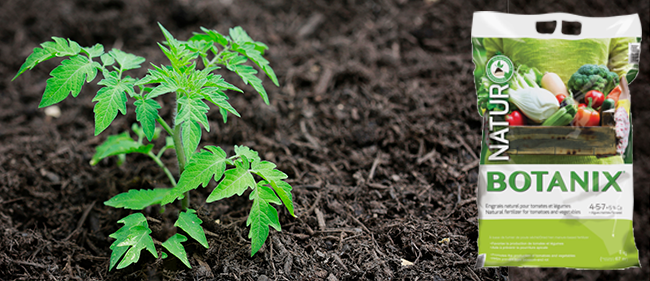Tomato plants require a lot of sun and watering, good fertilizer, tutors and pinching out suckers. How to care for them.
From sowing to outdoor planting, you have not been idle! If you now think you are resting on your laurels, think again: the tomato requires daily care and careful monitoring.
Plant care
Monitor and maintain your plants throughout the season to ensure an abundant harvest.
Watering
Tomato plants require a great deal of water to thrive. Rainy days aside, water every day, and container plants inn particular. Too much water is not good either, and avoid watering the leaves, since excessive moisture can lead to fungi developing. Watering early in the morning is preferable.
 Fertilizers
Fertilizers
Tomato plants remain in the earth for a long time and they are very nutrient-greedy. To satisfy their need for nutrients, add compost and a special tomato fertilizer around the base of the plant once or twice a month. You can also add liquid seaweed fertilizer to the water before watering, once every two weeks.
 Staking
Staking
Determinate plants grow to approximately 1 metre. A tomato cage will provide sufficient support.
Indeterminate plants can grow to 2 m high.
- Use bamboo poles, stakes or straight branches at least 1.5 m long and insert them deep enough into the ground so they won't bend under the weight of the fruit.
- Tie the plant to the stake with string or raffia every 30 cm throughout the growing period.
- To avoid impeding the grow-out of the stems or injuring the plant, make an 8 to secure the plant to the stake, leaving some slack around the stem.
There are other "training" techniques, such as cages, gates, trellises or tipis. Learn as much as you can about each technique and choose the one best suited to your needs.
 Pruning
Pruning
Small tomato plants (cherry tomatoes, gooseberry tomatoes) and determinate tomato plants do not need to be pruned.
Pruning indeterminate plants consists mainly of:
- Pinching out the suckers that grow in the crotch between the main stem and the leaf branches, or side stems. They are called suckers because they suck out the sap of the plant.
- Removing them means the plant has more energy to devote to growing fruit.
- Also, remove leaves that are touching the ground, since they can be conduits to disease. Near the end of the season, prune back the head of the plant so no new flowers will grow which won't have sufficient time to develop into fruit.
Some people claim that all pruning weakens the plant and that « wounds » on the plant open the door to disease. That's a decision you'll have to make!
 Harvest and care in autumn
Harvest and care in autumn
If you can, let your tomatoes ripen on the plant and harvest tomatoes when they are evenly coloured. Tomato plants are sensible and prefer warm temperatures. When the nights get cooler, they need to be pampered a little.
- Cover to retain as much heat as possible. The plants are fragile in the cold.
- Cut back on water and withhold fertilizer
- Prune the lower leaves so that the plant concentrates its energy on the fruits and not the plant
- Keep only well-formed tomatoes on the plant. Remove undersized flowers and fruit.
- The temperature drops below 10ºC? Pick the fruit. They will ripen inside.
- Store in paper bag along with an apple to ripen. it may not have the same vine ripened sweetness as if it grew on the vine.
- Compost or dispose of the plant. If you choose to compost, the temperature needs to be over 60ºC to kill diseases.
- Harvest and save seeds for next year
An alternate method is to pull the entire plant and hang it upside down in the garage or the basement. Keep temperatures between 15 and 22ºC.




